6 Listening to Trees: Provocations for a Sonic Kinesthetic Approach
Eleni-Ira Panourgia; Lisa Sandlos; and Rennie Tang
Introduction
In our ongoing collaborative project Sonic Kinesthetic Forest, we explore the following question: How can ecological empathy and agency be fostered through integrative experiences of drawing, sound, and movement within forest landscapes? We believe that such experiences connect humans more deeply to trees and forests at a moment that is both necessary and timely; therefore, our work proposes the use of interdisciplinary practice to strengthen human-tree relations. Through intentional attunement to sensory perception and by engaging in eco-somatic artistic activities, humans can experience closer connections to nature while being agents for ecological transformation. Endeavouring to reveal the aliveness[1] and ongoing transformation of trees and forest landscapes, we offer scores as provocations for exploration and experimentation that combine sound and listening, somatic movement, and embodied drawing. In the following paragraphs, we outline methods and approaches that can be utilized for sonic kinesthetic engagement with trees and forest landscapes.
Themes for Sound and Listening
Listening and sound are approached in relation to movement and the visual characteristics of landscapes. Modes of deep listening[2] and perspective listening[3] offer opportunities for tuning into sounds of trees and forest landscapes from within human and more-than-human bodies. Performing together with trees using found objects, touch, movement, and vocalization enables synergetic and respectful sonic processes between trees and humans. Field recording can be used to document aural traces of such interactions with trees, while verbal or visual notations can be used to communicate the sensory experience and further invite performative opportunities across sound, movement, and drawing.
Themes for Movement Explorations
Bodily attunement is a starting place for acknowledging common aspects of existence for both humans and trees. Respiration is a shared process that relies on an exchange of oxygen and carbon dioxide (CO2), so noticing the movement of breathing is foundational. Through close observation of how trees move and through movement improvisation, humans can develop “kinesthetic empathy”[4] to better understand the expressive capacity of trees. Translation of multiple sensory experiences into movement expression and written or oral reflection on movement experiences are also ways of strengthening symbiotic relationships between humans and trees.
Themes for Drawing Practices
To explore the sonic kinesthetic qualities of trees we use expressive abstract drawings to engage in the non-visual and sensorial attributes of a space rather than its visual aspects. Scores in the form of notational drawings can be used to document body-space-sound relations over time and/or as provocations for movement and sound performances. For example, the interplay between drawing and movement can be found in the works of Trisha Brown, Anne Teresa de Keersmaeker, and William Forsythe, among many others.[5] Co-creations between drawing and sound may emerge through graphic compositions of landscape textures,[6] along with spatial visualisations of sound as in the scores of composer Iannis Xenakis.[7] The making and interpretation of scores invites the body to become a drawing instrument that invokes visualizations of the sound and movement of trees.
Sonic Kinesthetic Provocations for Engagement with Trees and Forest Landscapes
Through a combination of the interdisciplinary approach described above across sound, movement, and drawing, we wish to encourage your engagement and interaction with trees and demonstrate how sonic kinesthetic experiences can be structured as scores and enacted in relation to real or imaginary trees.[8] One such score is presented below, including an open-ended activity followed by six structured provocations. We invite you to follow this score (and create your own original scores), either in an outdoor setting, such as a forest or a park, or indoors (e.g., a classroom or any space with room to move).
Warm-up: Open-ended activity
Approach a real tree or imagine a tree in front of you. Touch the tree’s bark. Are the textures rough, bumpy, patchy, striated, peeling? Express your sensation of the textures by moving your body. Now imagine some sounds that correspond to these textures; use your body and objects you find around you to make sounds that express the qualities of those textures. Trace the textures of the tree bark with your fingers. Now draw the forms and rhythms of the textures in the open space around the tree. Experiment with using your hands, wrists, arms, torso, hips, legs, feet, and other body parts to initiate your movements as if you are drawing on a large imaginary canvas.
Six provocations
The following six provocations can be enacted outdoors, in real space, or in your imagination. The provocations are structured around the action of approaching a forest landscape from far away, moving closer toward a singular tree.
I. Approach a forest, group of trees, or a single tree from afar. Listen to the whole soundscape and respond with movements of your hands. Trace the outline of the tree canopies and the surrounding landscape of sky, clouds, and structures, gesturing with your fingers. As you move closer to the trees, expand your gestures to use your arms, shoulders, and entire body until you arrive at the trees.
 |
 |
| All photos by Rennie Tang, licensed under a CC-BY-ND 4.0 International Licence. | |
II. Stand in the middle of a forest, within a group of trees or facing a single tree. Close your eyes or soften your gaze. Tune in to the surrounding trees with your whole body, listening to the sounds around you, both the distant ones and those near to you. Draw or imagine spirals in the space around you and circular gestures to connect body, tree, and breath, making visible the exchange of oxygen and CO2 between your body and the trees around you. Tune in to the flow of your breathing and the respiration of the tree, and to the tree-body together with your body as they expand and contract.
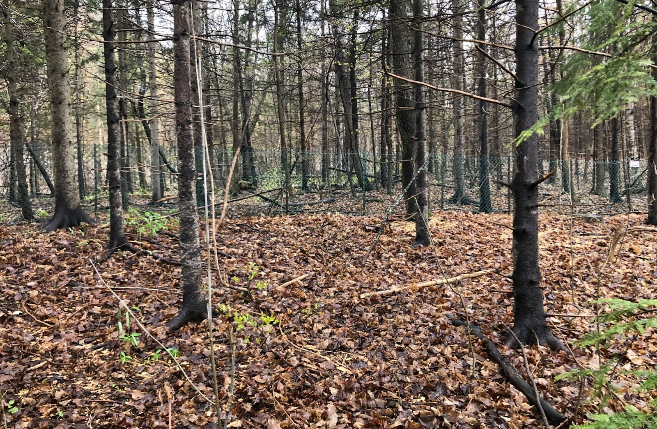 |
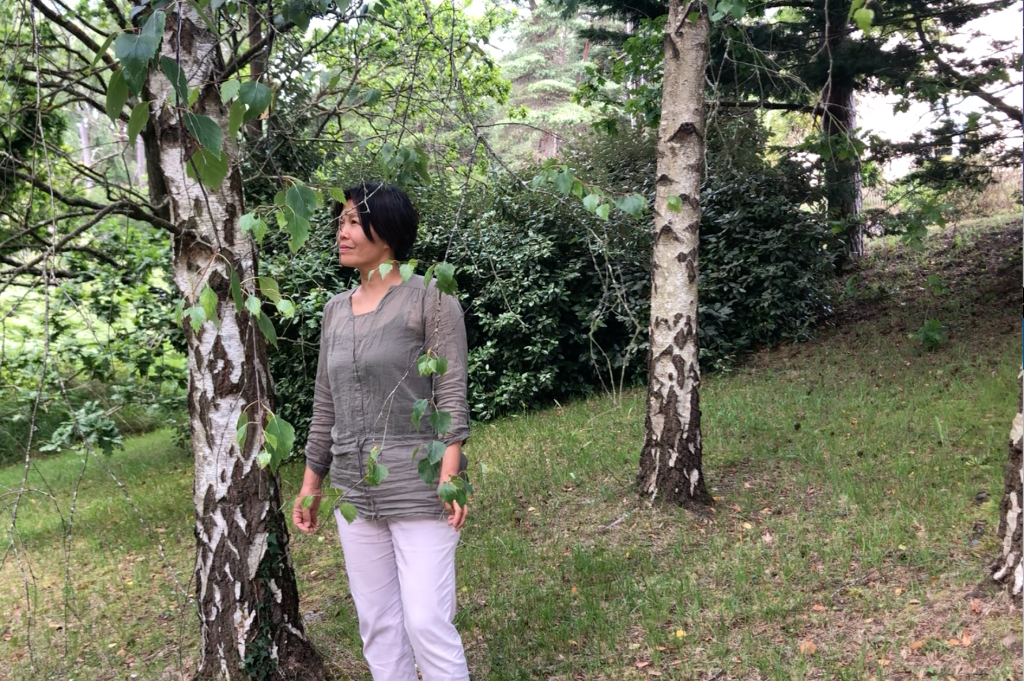 |
III. Stand in front of a tree. Closely observe the movement of a real or imagined tree before you. Feel the shared verticality of your spine and the tree trunk. Move and listen, playing with lengthening, sinking, shrinking, and swaying within the vertical dimension. Make an imprint of that vertical play on your imaginary canvas.
 |
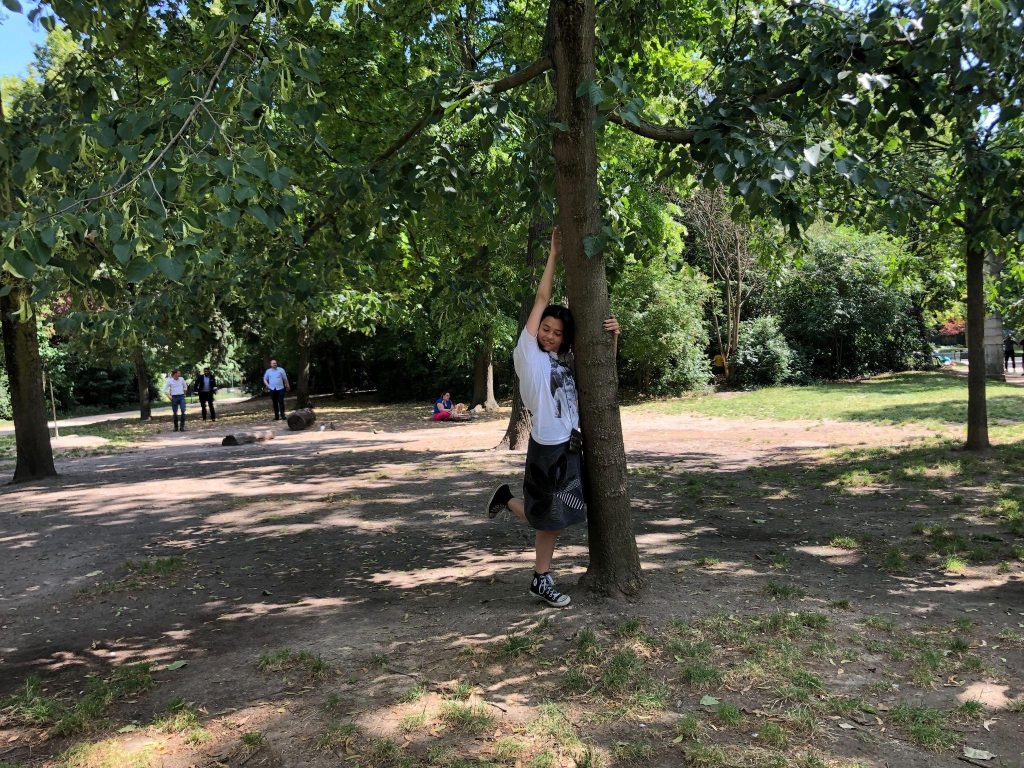 |
IV. Stand closer to or in contact with a tree. Sense the contrasting movements between your lower body (i.e., your roots and base of your trunk) as stable and strong and your upper body (i.e., your upper trunk, branches, and leaves) as mobile and supple. Play with and listen to the various rhythms of these lower- and upper-body movements, accelerating or decelerating, or starting and stopping. Make marks on your imaginary canvas that correspond to these rhythms.
 |
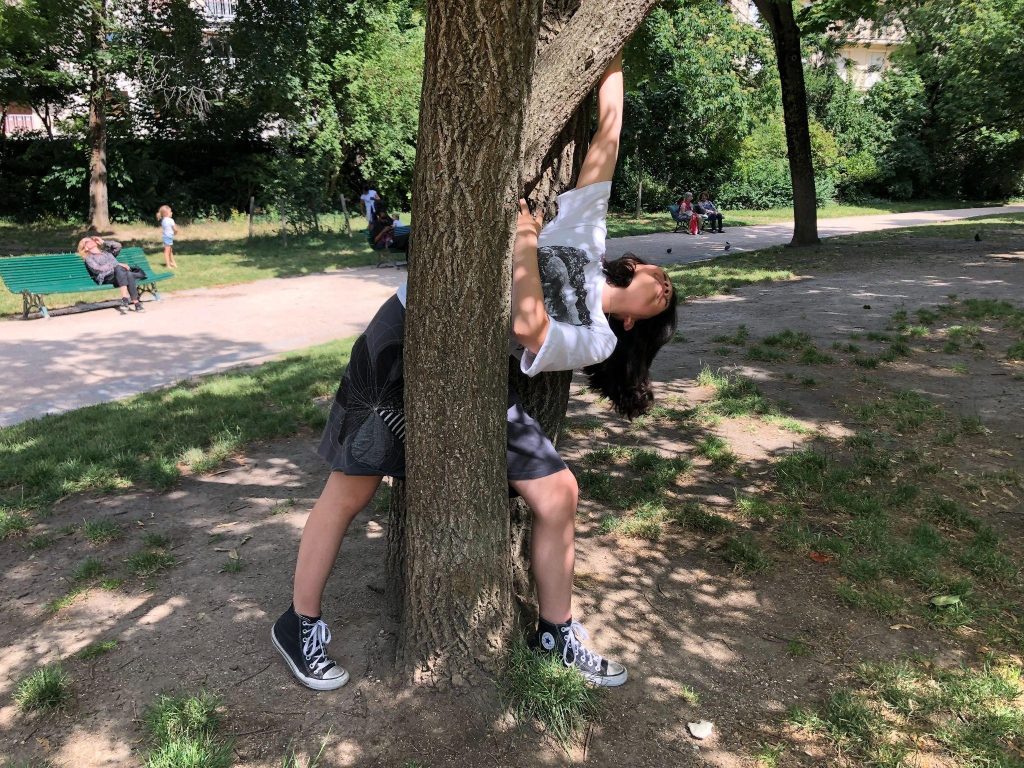 |
V. Lie on the tree roots. Place your ear to the ground. Listen to the water flowing and being absorbed up through the roots. Allow the entire surface of your body to settle into the earth at the base of the tree trunk. Drop the weight of your body into the ground, expand your listening, and move (e.g., roll, slide, crawl, sweep, tap, etc.) on the ground as if it is a canvas.
 |
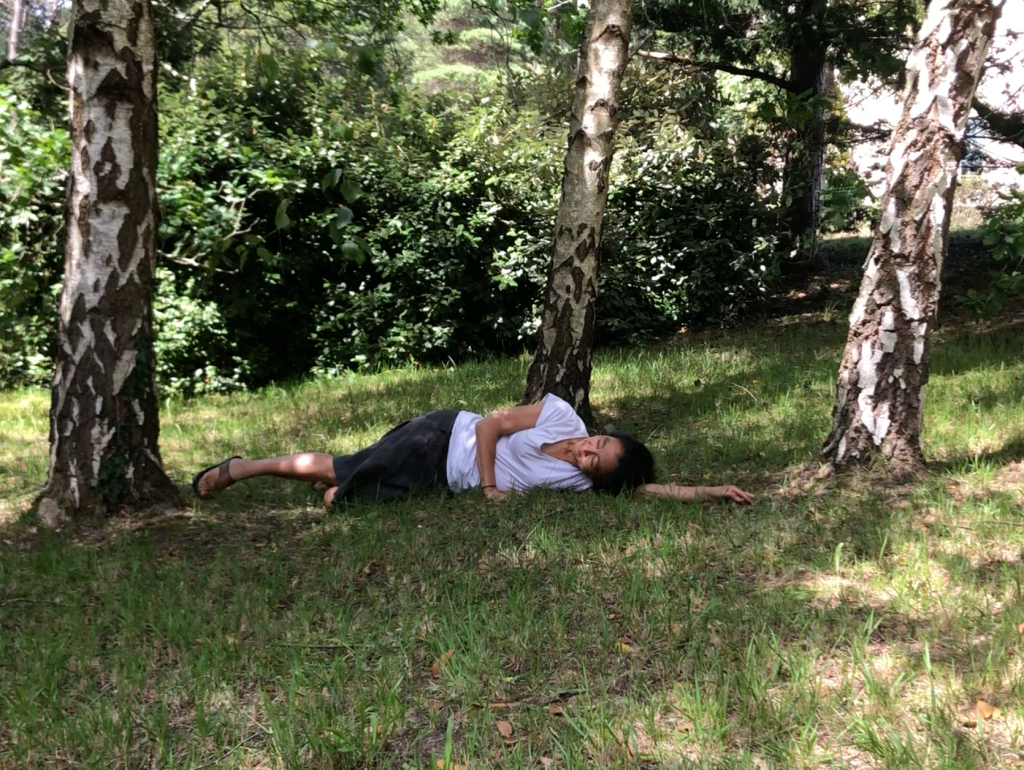 |
VI. Touch a tree. Touch the tree, explore the textures of the bark, and translate your sensation of touch into bodily movement. Listen to the textures and draw what you hear. Explore your sensory and affective experience of being with the tree.
 |
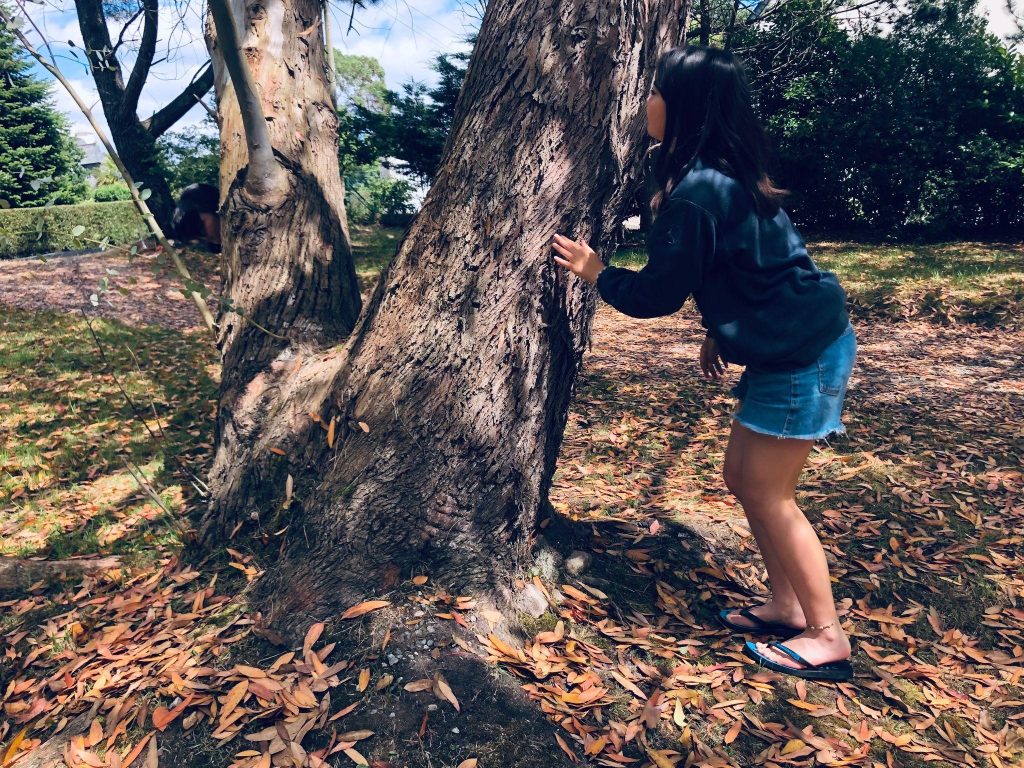 |
Concluding Thoughts
Sonic kinesthetic expression responding to real or imaginary forest landscapes can be the impetus for deepening human-tree relationships. The provocations we have proposed generate opportunities for expanding our perception through encounters with tree-bodies. Which ideas, sensations, or feelings did the provocations evoke in you? As you take time to contemplate and experience your relationship with trees, we invite you to share these provocations with other humans or trees weaving together your interpretations of sounds, shapes, movements, and textures.
- T. Ingold, Being Alive: Essays on Movement, Knowledge and Description (London: Routledge, 2021). ↵
- P. Oliveros, Deep Listening: A Composer’s Sound Practice (New York: IUniverse, 2005). ↵
- A. Wand, “Court of Cicada,” Mapping Sonic Futurities, accessed May 1, 2023, https://mappingsonicfuturities.com/court-of-cicada. ↵
- J. Martin, The Dance in Theory (Princeton, NJ: Princeton Book Company, 1965). See also S.L. Foster, “Movement’s Contagion: The Kinesthetic Impact of Performance,” in The Cambridge Companion to Performance Studies, ed. T.C. Davis (Cambridge: Cambridge University Press, 2008), 46–59; S.L. Foster, Choreographing Empathy: Kinesthesia in Performance (London: Routledge, 2011). ↵
- P. Eleey, “If You Couldn’t See Me: The Drawings of Trisha Brown,” in On Performativity, vol. 1, Living Collections Catalogue, ed. E. Carpenter (Minneapolis, MN: Walker Art Center, 2014), http://walkerart.org/collections/publications/performativity/drawings-of-trisha-brown; A.T. De Keersmaeker, Work/Travail/Arbeid (Exhibition), MoMA, New York, March 29–April 2, 2017, https://www.moma.org/calendar/exhibitions/1626; W. Forsythe, William Forsythe: Improvisation Technologies. A Tool for the Analytical Dance Eye, CD-ROM and booklet (Karlsruhe, DE: ZKM, 1999). ↵
- M. Schafer, Snowforms (Toronto: Arcana Editions, 1986). Found at the Canadian Music Centre; item catalogued by Clara Lockhart, University of Ottawa. ↵
- S.C. Yan and A.L.M. Rodrigues, “Iannis Xenakis’ Drawing Expands the Morphological Intuition-Thought Inside Musical Composition,” in Creating Through Mind and Emotions, ed. M.S. Ming Kong, M. Rosário Monteiro, and M.J. Pereira Neto (Boca Raton, FL: CRC Press, 2022), 397–401. ↵
- R. Tang, E.I. Panourgia, and L. Sandlos, “Sonic Kinesthetic Forest: Listening to and Dancing With Trees,” Proceedings of the European Conference on Arts, Design & Education (Porto, Portugal, July 7–10, 2022), https://doi.org/10.22492/issn.2758-0989.2022.17. ↵

